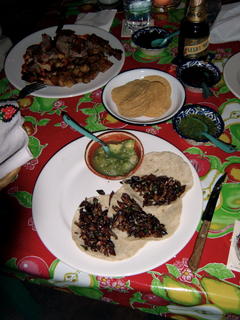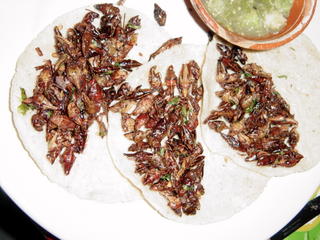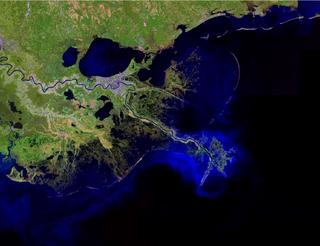I was in Puerto Vallarta, Mexico, last week (work, not play), and we went out to a restaurant called "El Arrayán," which had dishes from various regions of Mexico on the menu, prepared by a chef trained at a Swiss cooking school. So there were all sorts of shi-shi variations on the menu, but not so far from traditional that it could not be called Mexican.
One of the things on the menu were chapulines, or grasshoppers. Now I had seen these on various TV shows, and knew that they were eaten in Mexico, and I was in just the right mood to dare ordering them.
They were yummy. Let me rephrase that: THEY WERE YUMMY. Here are the requisite photos:

They were a lot smaller than I expected. The salsa was a avocado-poblano sauce with lime (quite yummy by itself). The best way to describe the taste is roasted black tea leaves.
I ate two of the little tacos, and my boss ate the other (and she greatly enjoyed it too). Out other dining companion dared to taste a single chapulin, and was gracious to say it was nice.
My son and my wife were completely grossed out by the photos, when I returned - I have to say that the photo of course only leaves you with that uneasy feeling you get when faced with an unfamiliar food. I couldn't tempt them with the smell and taste, which were very un-insectlike. When eating insects, one has to consider that they are very similar to shrimp. Still, whoever ate the first shrimp, lobster or grasshopper was brave, in any case. They are all ugleeee.
A little more on the restaurant - they have a website. Carmen, the owner, is a spunky little elf of a girl, who has taken on a tough business. The location and the decor are great - it reminded me very much of old houses in hot country in Colombia - thick, whitewashed adobe walls that are painted in color on their lower halves, narrow shuttered and barred windows overlooking the street. Plenty of old terra cotta tiles, and lots of hanging potted plants.
- El Arrayán
- Allende #344 Colonia El Cerro
- +52 (322) 222 71 95
- info@elarrayan.com.mx
The interior was also decorated with some amazing Huichol art - brightly colored yarn is laid down into beeswax-coated wood in intricate patterns that are said to have their origins in peyote-indiced visions. The set displayed in the restaurant are Carmen's inheritance from her grandmother, and are in amazing condition after having been in storage in Mexico DF for over 25 years. Here's one of them:
